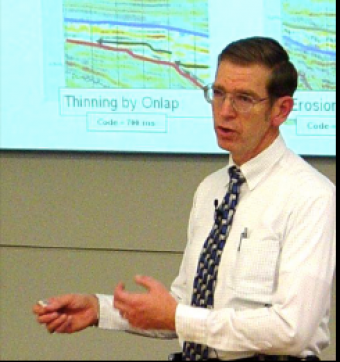Date: November 2, 2016 1h 5min Advanced
Time-depth conversion is important throughout the exploration/development/production cycle, as inaccurate depth conversions can lead to poor business decisions. Integration of geologic knowledge is the key to a good depth conversion - what geologic factors control the subsurface velocity structure?
Divide the class time into three (3) segments: (1) review the previous exercise, (2), introduce the lecture, and (3) introduce the exercise presented here. The review of the previous exercise has five (5) slides, and will take ~8 minutes to explain. The lecture material presented here has 45 slides, and will take ~50 minutes to explain. The introduction to the exercise presented here has four (4) slides, and will take ~7 minutes to explain.
In this exercise, the students analyze work on converting horizons on a seismic line from units of two-way time (TWT) to units of depth in meters. The bulk of the work has been done. They complete a table for 2 out of 10 locations and then sketch the horizons in depth on a graph. On the time section, the high point for the deepest horizon is at Location D. Due to the velocity structure, the high point on the depth section is at Location E. This is the main take-away from this lesson – that time structure is not always the same as depth structure. This exercise should take about 15-20 minutes.

This course, based on teaching material from Dr. Fred Schroeder (formerly of Exxon/ExxonMobil), reflects on the geology and geophysics basics for the petroleum industry. General geology and basic geophysics are not required, but helpful with the material.